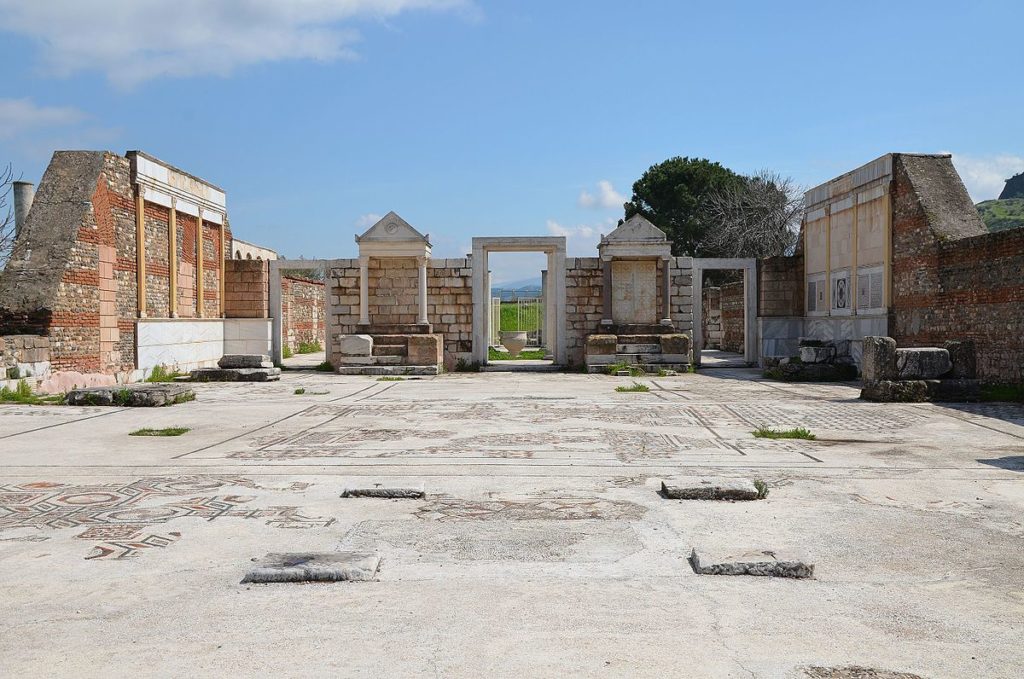[Greek] ἀγωγή (agōgē), [Latin] institutionem: a carrying, a leading away, a guiding conduct, a bringing up, a mode of life, a manner of life, behavior, way of life, training, a teaching, a course of life, a rearing, a persuasion; 2 Tim.3:10

Sardis Synagogue was the center of Jewish life (3rd century B.C) in Turkey during the Late Roman period.
Background Information:
Ancient Greece: This term, primarily used in Spartan culture, means (or place) for leading, training, guidance, and rearing. This was the rigorous education and training program required for all male Spartan citizens, excluding the first-born sons in the ruling families. This training involved learning stealth, loyalty, military training, hunting, dancing, singing, and social skills. This system was intended to produce strong and capable young warriors who could serve the state. This term, in philosophical circles, denotes a choice or way of life.
Old Testament: The Hebrew counterpart to agoge was called the Halakha. The Halakha was essentially a collective body of laws which governed religious principles and beliefs and aspects of ordinary life of the Jew. The Halakha was derived from the written and oral tradition of the Torah. Historically, the Halakha provided guidance to many Jews of the Diaspora. It was important for the Jew to maintain and uphold his cultural traditions wherever he lived. Just as she had when she was being brought up by him (Esth.2:20). The Jew Mordecai was seeking the good of his people (Esth. 10:3). The very people whose manner of life they emulated (2 Macc.4:16). A decree was issued ordering the neighboring Greek cities to adopt the same measures (2 Macc.6:8). We have heard that the Jews prefer their own way of life (2 Macc. 11:24).
New Testament: This term, occurring only one time, essentially refers to the example (model) provided by Paul. This term refers to one’s behavior, orientation, and character, formed and shaped by one’s master (teacher). Paul calls for Timothy to follow his example. Paul calls Timothy to be steadfast in the face of persecution and to be faithful to what he has been taught.
Scripture:
“You have followed my teaching, way of life, purpose, faith, patience, love, and endurance.” 2 Tim. 3:10
Paul calls upon Timothy to follow his example. The teacher (master) disciple relationship becomes an important institution in the Judeo-Christian culture.
Conclusion:
Synagogue, anagogical, pedagogy, demagogue, institution
It seems that these Spartan schools are perhaps not much different from the ancient gymnasia. The gymnasia also trained students in athletics, philosophy, literature, and music. This is where the young person would receive a well-round (enkuklios) education. The Greek paideia means child-rearing. Essentially, an encyclopedia means an education in the circle of arts and science.
Many Jews emigrated to other regions in the Mediterranean region during the Diaspora. Even though they were in foreign lands, it was very important for these dispersed Jews to maintain their Jewish identity and character wherever they lived. Although these Jews often adopted the Greek Hellenistic customs, they still maintained their Jewish identity. So it is not surprising that they would refer to the Torah and Halakha for guidance. These Jews would gather or assemble together. Syn- means together. The synagogue becomes the Jews’ place of worship, where they would practice their spiritual way of life.
Pedagogy is the method and practice of teaching to children. Anagogy is elevating the mind to spiritual sense. Therefore, the anagogical sense of the bible refers to its spiritual sense. A demagogue is a political leader who seeks support appealing to popular desires and prejudices rather than rational arguments.
